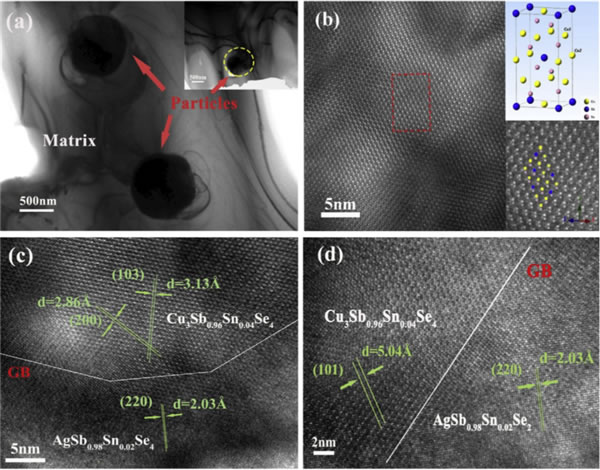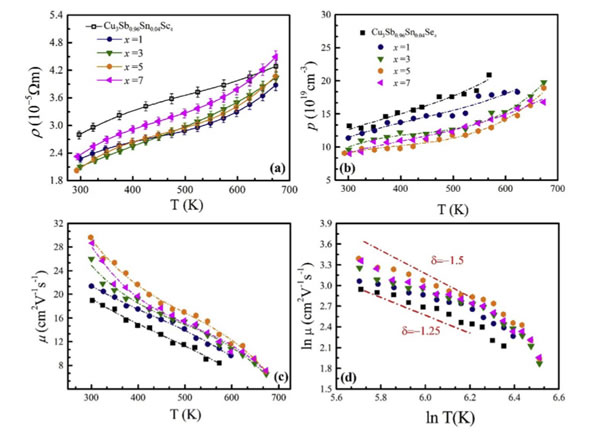Hefei Research Institute has made progress in the research of copper antimony alloy thermoelectric properties
Recently, Qin Xiaoying's group, a researcher at the Institute of Solid State Physics, Hefei Institute of Material Science, Chinese Academy of Sciences, has made new progress in the study of Cu3SbSe4 thermoelectric properties. By synergistically regulating power factor and thermal conductivity, the thermoelectric performance of copper-antimony alloys can be improved. Related research results were published on Materials Today Energy. With the development of the industrial society, the supply of fossil fuels has decreased, and providing a sustainable energy supply for the world population has become a social problem in the 21st century. Thermoelectric materials can be used as solid-state refrigerators or heat pumps without moving parts or liquids harmful to the environment. Thermoelectric technology makes the direct conversion between heat and electricity possible. Therefore, it is considered a promising energy-saving means to achieve sustainable power generation. The efficiency conversion of thermoelectric materials is defined by the dimensionless thermoelectric figure of merit ZT. In recent years, Cu3SbSe4 has attracted the attention of scientists due to its low cost of constituent elements, low intrinsic lattice thermal conductivity and excellent electrical transport properties. However, most researches focus on improving the thermoelectric properties of Cu3SbSe4-based materials, and there is no effective method to significantly increase the power factor while reducing the thermal conductivity. In this study, the researchers introduced AgSb0.98Sn0.02Se2 particles into the Cu3Sb0.96Sn0.04Se4 matrix, and formed Cu 3 Sb 0.96 Sn 0.04 Se 4 /x wt%AgSb 0.98 Sn 0.02 Se 2 through grinding and spark plasma sintering technology (X = 0, 1, 3, 5, 7) Nanocomposite materials. The study found that due to the decrease of thermal conductivity and the enhancement of carrier mobility, the ZT value of Cu3Sb0.96Sn0.04Se4/5wt%AgSb0.98Sn0.02Se2 samples reached 1.17; the thermal conductivity decreased by the multi-scale second phase AgSb0 .98Sn0.02Se2 enhances phonon scattering; the new acceptor energy level caused by interface defects causes an increase in mobility and a decrease in carrier concentration, thereby further increasing the power factor. This study shows that the embedding of AgSb0.98Sn0.02Se2 particles in the Cu3Sb0.96Sn0.04Se4 matrix can significantly improve its thermoelectric performance. The research work is supported by the National Natural Science Foundation of China. SUN YAT INDUSTRY LIMITED , https://www.ernte-eu.com
Figure 1. (a)-(c) Cu 3 Sb 0.96 Sn 0.04 Se 4 /5wt%AgSb 0.98 Sn 0.02 Se 2 low-magnification TEM images; (d) Cu 3 Sb 0.96 Sn 0.04 Se 4 matrix and structural model HRTEM image (similar to Cu3SbSe4[021])
Figure 2. The electrical properties of Cu3Sb0.96Sn0.04Se4/x wt%AgSb0.98Sn0.02Se2 (x = 0, 1, 3, 5, 7) composite samples in the temperature range of 300-673 K: (a) Resistivity ( Refractive index); (b) carrier concentration; (c) mobility; (d) logarithm of mobility versus temperature
Figure 3. (ab) The total thermal conductivity and lattice thermal conductivity of all samples in this study as a function of temperature; (c) Schematic diagram of the phonon transport process in the composite; (d) the temperature range of all samples ZT value